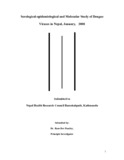Please use this identifier to cite or link to this item:
https://hdl.handle.net/20.500.14356/304Full metadata record
| DC Field | Value | Language |
|---|---|---|
| dc.contributor.author | Nepal Health Research Council (NHRC) | |
| dc.date.accessioned | 2012-12-31T00:09:50Z | |
| dc.date.accessioned | 2022-11-08T10:14:17Z | - |
| dc.date.available | 2012-12-31T00:09:50Z | |
| dc.date.available | 2022-11-08T10:14:17Z | - |
| dc.date.issued | 2008 | |
| dc.identifier.uri | http://103.69.126.140:8080/handle/20.500.14356/304 | - |
| dc.description.abstract | Objectives: To know the sero-epidemiological, molecular information of dengue virus (DV) and Japanese encephalitis (JE) in Nepal and to characterize these viruses at molecular level Background: Dengue fever (DF) and more severe forms namely dengue hemorrhagic fever (DHF) and dengue shock syndrome (DSS) are caused by dengue virus, transmitted by Aedesmosquito. DF/DHF is primarily a disease in tropical and sub tropical areas of the world. Dengue virus infection occurs in more than 100 countries and over 2.5 billion people live in the areas with a risk of infection. Up to 100 million cases of DF and 500,000 cases of DHF and several thousands deaths are estimated to occur annually worldwide. During the past decades, dengue virus emerged in South Asia and DF/DHF epidemics occurred in Bhutan, India, Maldives, Bangladesh and Pakistan. In Nepal, the first case of dengue was reported on 2004 from Chitwan district. The recent outbreak of 2006 was observed in nine districts of Terai including Banke, Dang and Parsa, posses a serious threat of future epidemic of dengue in Nepal. Methods: A total of 422 serum samples were collected during viremic period from the patients suspected DF, JE and other viral illness from August to November 2007 in nine districts of Teria region of Nepal and 127 samples were also collected from asymptomatic individuals. IgM ELISA, IgG-ELISA was performed using particle agglutination assay (PA) and IgM ELISA kit on serum samples for both dengue and JE. RNA extraction was performed using QIAGEN RNA EXTRACTION kit from the serum samples collected during viremic phase followed by RT-PCR. Result:The result showed that 28 % of the cases were positive for dengue-IgM out of 422 collected serum samples. There was no haemorrhagic manifestation observed among the patients. Bardiya districts showed highest percentage of positive dengue antibodies (64%). Stegomyiaindices seasonal changes related to rain were identified in all the major cities affected during the 2006 DF/DHF outbreak. To know the possible time of interdiction of dengue in Nepal, IgG ELISA was performed and gave only one positive case out of 127 asymptomatic individuals. Among analysed IgM antibody positive cases, 69.06% were male and 30.88% were female and the highest numbers of positive cases were found in an age group 21-30 (29 %). There was no significant difference was observed in relation to age, sex and occupations of the patient and dengue infection. Two serological methods, PA and ELISA were used to compare their sensitivity and specificity for the detection of IgM antibody of dengue and the result showed that PA assay has sensitivity of 98 % and specificity of 96%, a positive predicts value of 0.90 and negative predict value of 0.99 in comparison with IgM-capture ELISA. Since PA assay does not required sophisticated instruments and specialized manpower it could be useful and reliable diagnostic test to support clinical diagnosis in district hospitals of Nepal. Molecular diagnosis based on RT-PCR was also performed in an optimize condition for rapid and confirmatory diagnosis and to know the dengue serotype prevalent in Nepal. However, RT-PCR failed to show positive for dengue indicating inappropriate time for collection or transportation. Virus isolation is undergoing with the collaboration of international collaborator. | en_US |
| dc.language.iso | en_US | en_US |
| dc.publisher | Nepal Health Research Council | en_US |
| dc.subject | Dengue Viruses | en_US |
| dc.subject | Nepal | en_US |
| dc.title | Serological-epidemiological and Molecular Study of Dengue Viruses in Nepal, January, 2008 | en_US |
| dc.type | Technical Report | en_US |
| Appears in Collections: | NHRC Research Report | |
Items in DSpace are protected by copyright, with all rights reserved, unless otherwise indicated.

